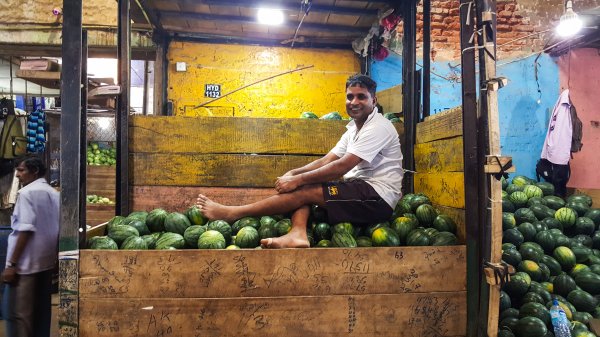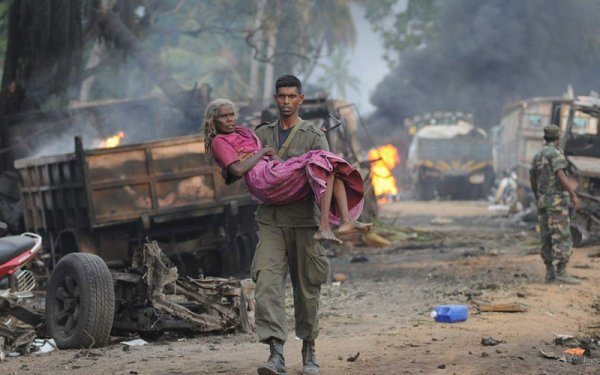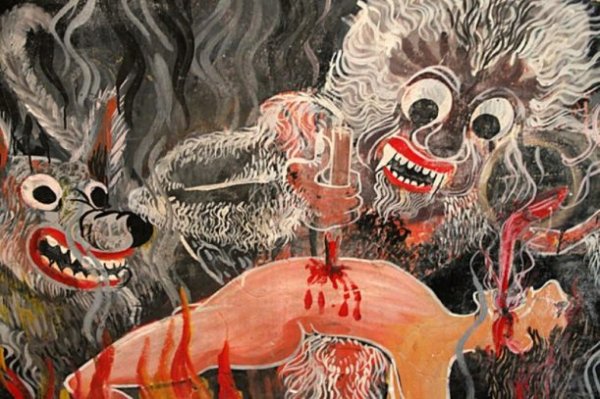
Last week Roar brought you six types of Sri Lankan expats you’d be likely to bump into in Australia. Well, seeing as how we Sri Lankans can be a diverse lot wherever we go, six types is far too narrow to box ourselves into (even for the purpose of satire and a few good laughs) so here’s the rest of the extended list. Enjoy:
7) The Lankan Cricket Connoisseur

They may have moved all the way Down Under, but Sri Lankans have not left behind their love for Lankan cricket. Image Credit criclife.com/Getty Images
For its fans it is the ultimate sport on the earth. For the rest… well, for them it’s too long, dreary, complicated, and boring. Even in the birthplace of the game, it’s played only by a select few belonging to a certain class. Down Under, people are only interested in it during the months of October and March. Yet, it can be said that in the subcontinent, and perhaps the Caribbean, cricket is sometimes more popular than any religion.
This is no exception for the Lankan Cricket Connoisseur expat, except for the vital difference that their love is only for Lankan cricket. Regardless of where they live, their love affair with Lankan cricket transcends all possibility and probability. When there is Sri Lankan cricket on, the rest of the world does not matter. Food, work and nagging spouses are just a blur – prompting the famous quote from Shehan Karunatilaka’s Chinaman: “When Lankan cricket becomes sweeter, your wife becomes sourer.”
Many of these fans have spent torturous nights unable to get any updates on Sri Lankan cricket matches. For them the birth of ESPN Cricinfo was like alien technology, the X-factor that finally saved them all. It would be near impossible to find a cricket connoisseur who hasn’t spent countless hours mediating to the commentary on Cricinfo. Many an expat Down Under would count the days to when the Sri Lankan team toured Australia. They were so eager, and ever so starved of Lankan cricket, that they would fill up even the practice matches But that is nothing, once the international fixtures start, they would march in, a sea of never ending blue, full of pride and passion, ushering in their carnival like atmosphere and home made cutlets and seeni sambol sandwiches, into the grounds and outnumber, out-cheer and out-cry their Aussie counterparts. Especially after days like the Brisbane ODI of 2013 all Sri Lankans Down Under walked through the streets with an exuberant sense of overwhelming pride, that had not been seen here since March 1996. Lankan Cricket Connoisseur expats have shared moments of cricketing brilliance and plummeted to depths of despair, all while playing their papare music and dancing away in the stands. It is fair to say that while these cricket obsessed expats may not be the coolest guys to hang out with, they have always brought a lot of colour, passion and excitement to the otherwise boring Australian cricketing summer.
8) The Mercedes Driver
 The icon of the elite, the symbol of the Sri Lankan who’s graduated from the Toyota days. Image Credit: wikipedia.org
The icon of the elite, the symbol of the Sri Lankan who’s graduated from the Toyota days. Image Credit: wikipedia.org
As much as we hate to admit it, Sri Lanka seems to have a bit of a ‘boasting’ culture. We sometimes like to show off what we have; either to make us feel good about ourselves, or others feel bad. We are all familiar with the story of the naya (snake) in the house. For our younger readers, it goes a bit like this: a housewife in a startled voice would say, “Aney mey, a big snake got into our house the other day, noh! It went from room to room, over the TV, then the Buffers and VCR, over the kavichchi, through the dining room, past the microwave, fridge and finally… maara thing, it went outside over the AC!”
The expat version of this infection is the Mercedes Benz expat. Now, cars are fairly expensive in the island, and you have to be above quite a few pay grades to afford a Honda, let alone a Merc. While cars in Australia are a bit more expensive than in the rest of the developed world, they are still more affordable than in Lanka.
So this particular breed tends to use a Mercedes car as their medium to express to the world that they can afford the best of what Europe has to give. It doesn’t matter what class or model it falls under, as long as it has the Mercedes badge on the front. This somehow gives them a sense of accomplishment, the feeling that ‘I am driving a Benz noh, I made it.’
They also have guerilla tactics to reinforce this point. This involves washing the car almost every day in their driveway, (which, by the way, stopped after the Victorian Government brought in new water usage restrictions during a heavy drought period) and wearing Mercedes branded clothing and accessories, implying that they received it with the purchase of the vehicle. It should be noted, though, that this particular expat is in every aspect the polar opposite of the Toyota Driver (covered in our previous article).
Additionally, this has led to a few more subsets of boastful groups, particularly the CK Underwear, Ralph Lauren Polo Shirt and Tag Heuer Watch Wearing Expat. Show us someone who has all four, and we will show you a unicorn.
9) The Kandos Man
 One of the more unconventional cravings of Sri Lankan expats in Australia. Image Credit: kandos.lk
One of the more unconventional cravings of Sri Lankan expats in Australia. Image Credit: kandos.lk
After years of disdain, and the Mukunuwenna saga, the Sri Lankan community here has performed wonders in getting everything from home available at the expense of a 10 minute drive. There are quite a large number of Sri Lankan groceries that trade almost everything from back home. This is not just limited to food: these stores stock everything from spices to dried fish, to string hopper making apparatus, to pittu boilers, to clay pots, and even DVDs of Lankan dramas. But the one item that seems to be impossible to find in shops here, the forbidden fruit, the holy grail, is Kandos chocolate.
Now you may ask, why would anyone indulge in Kandos when they have an unlimited selection of hand crafted artisanal drops of heaven at their fingertips? This is something that has baffled us as well. However, we cannot deny the fact that there are quite a few expats here who regularly crave the taste of Kandos. The Cashew Nut and Orange varieties to be specific. They wouldn’t even look at another chocolate, but the sight of Kandos makes their mouths water and their legs buckle. These expats regularly ask travellers from the island to bring as much Kandos as they can stuff into their suitcases. Sometimes they even ask interstate friends to bring some and post it to their homes.
But the supply is still insufficient to feed the demand. Incidentally, no one can seem to answer the question as to why Kandos is not available in Australia. If there ever were a Sri Lankan X-Files, this would be in the thick of it. To add to the mix, there are rumours of a Sri Lankan expat living in Melbourne who has a pipeline to supply Kandos to those who have a dire need of it. Recently, however, a batch of Kandos saw its way to the customs bin at the Sydney airport. If Kandos was cocaine (to some Sri Lankans, it clearly is), this is what the news story would sound like:
Sydney – In a major contraband bust, Customs officials at Sydney Airport claimed to have seized a sizeable amount of Kandos Cashew Nut chocolate from a passenger returning from Sri Lanka. The items were seized from a Singapore Airlines flight which landed at the Sydney airport shortly after midday, on 6 January. The suspect was detained and questioned but later released. The estimated street value of these is roughly around AUD10.00.
An airport spokesperson confirmed that Mr. K Kumara Saramaasse (name has been changed to protect identity), had pleaded guilty to bringing in the banned item to the shores of Australia. What the authorities were unable to get out of him was the item’s intended final destination. When questioned he simply said, “Sir, that is for my many girlfriends, who all like the best chocolates from Lanka noh.’ Given the sincerity of his nature, and the inability of authorities to confirm that a serious crime may be committed in the near future, Customs services decided not to press any charges and released him with a stern warning and zero goodies to take home.
Our sources from deep within the inner sanctum of the Sri Lankan community in NSW have also confirmed the news. Another source from within the community revealed that these chocolates were intended for the infamous Kandos Man, though it has not been revealed which Australian state the final destination of the item would be. Some other notable Lankan delectables were also taken by the authorities, though it has been confirmed that they fall in the lower spectrum of the most wanted items list.
While it has been suspected that the Kandos Cashew Nut variety has regularly been making it past our closed borders, this is the first time authorities have been able to pinpoint any and make a definite bust.
Authorities admitted that they got lucky with this catch, as it was the breakage and leakage of a bottle of home extracted extra virgin king coconut oil that lead the resident exotic food detection specialist’s trained nose to the culprit’s luggage. The oil spillage had covered a rather large portion of the suitcase, which also included a sizeable package: snuggled between packs of dodol, kokis, cake and chilli paste, were the much sought after Kandos chocolates.
Whether the intention of the chocolates was to woo (or woe) the ladies, or whether they had a secret sinister motive, one thing is for sure: someone somewhere is missing their new year’s Kandos.
10) The Sinhala Speaker
 The beloved language that many a Sri Lankan expat refuses to part with. Image Credit: luc.devroye.org
The beloved language that many a Sri Lankan expat refuses to part with. Image Credit: luc.devroye.org
For the longest time (about 133 years), Sri Lanka was an English colony. This, of course, has left a bit of Britishness in us. However, as everyone knows, until a certain overzealous Prime Minister made Sinhala the national language, we were speaking a fluent version of the Queen’s English. Ever since that day, the quality of English in the country has kept dropping and it’s now come to a point where a majority speak a localised version of the empire’s tongue. (Although linguistically speaking, we at Roar are amused as much as we are proud of this brand of Sri Lankan English). There is, however, a culture within Sri Lankans to use some type of English vernacular to exert a sense of superiority over others. There are instances where speaking in Sinhala is laughed at, or considered ‘godey,’ while the use of even broken English is revered. In some circles, young children are even told that Sinhala is to be used to communicate with domestic aides. Now, while we promote the mastering of English, we also find it extremely sad that Sinhala is degraded in such a way. Growing up, kids would regularly laugh at incorrect English spelling, while people hardly noticed poor Sinhala spelling. Our theory for this behavior is that it comes from an inferiority chip on the shoulder of people who try to deride others at every given opportunity.
Now the funny thing is, it seems that when a Sri Lankan lands in a foreign country, as always, they do a complete 180 and start to embrace all the things they distanced themselves from when they were back home. Just like reverting to eating rice, expat Sri Lankans living in Australia started conversing more and more in Sinhala. Down Under, conversing in Sinhala is the fashionable thing, including the unfiltered use of expletives. We even have a friend whose one time favourite hobby was shouting Sinhala expletives to others, while walking through supermarkets. There are also quite a few older expats who shed a few tears that second and third generation Sri Lankan Aussies don’t seem to speak or read Sinhala.
This passion is such that in Sri Lankan dominant suburbs, you can easily find a few infamous Sinhala tuition classes. The obsession over Sinhala is so much so that in Australia, getting into the Pahana, the local Sri Lankan community newspaper, is as prestigious as getting into the Hi!! magazine back home.
And last but not least, and what is probably the most common type of Sri Lankan Expat:
11) The quintessential Kalu Sudda
 The non-Sri Lankan-Sri Lankan has varying degrees of transformation. Image Credit: Gappiya: Kalu Sudda (The Foreigner)
The non-Sri Lankan-Sri Lankan has varying degrees of transformation. Image Credit: Gappiya: Kalu Sudda (The Foreigner)
The term “Kalu Sudda” has a rather negative undertone to it and doesn’t do justice to the effort required to be a true chameleon, so an apt description would be ‘The Aussie, The Britisher and/or The American.’ This type of expat is extremely common, and one can generally identify a number of varying degrees to them. (To be fair, you can spot a few of these types even in Sri Lanka.)
This noteworthy type prides itself in being notably non-Sri Lankan. That is, they seem to go out of their way to distance themselves from any association to the motherland. Now, as mentioned above, there are varying degrees of this transformation.
In the Larval stage, we see them make subtle disassociations with what makes them Sri Lankan. This involves the shortening of long-winded complicated names, and the abandoning of divine cuisine from the island. This stage is like the chicken and the egg: what changes first is a mystery. It is enough to know that both their name and choice of food changes. As covered in the previous article, under the ‘Name Changer’ type, out goes Siripala Malli and in comes Shane, or, in a weird twist, someone whose nickname among friends is “Mutchalinda” (a reference to the snake in Buddhist scripture and the ‘snake in the house story’) ends up as “Mutch,” which the guilty party no doubt thought was similar to Mitch or Butch.
The cuisine change first makes its appearance at the workplace. Out go the aromatic rice and curries, and in come tuna sandwiches. Team lunches at the local curry house changes to the local pub. Chicken curry is replaced by chicken parma.
At the Pupal stage, things are a tad bit harder to pull off, to some at least. This involves changing their English accents to fit the country. As Mahela Jayawardene put it recently, the biggest exponent of the accent change is none other than Kumar Sangakkara (no, really). We say it is hard, because, as comedian Jimmy Carr said, pulling off the perfect accent is merely not just pronunciation. It also involves timely usage of colloquial terminology.
Unfortunately, the budding Sri Lankan expats don’t seem to heed this golden advice. Not knowing who Jimmy Carr is, might have played a part in it. Here Down Under, apart from a very select handful of punters (Aussie slang for a betting man), they overwhelmingly forget to incorporate typical Aussie icons such as “Ripper,” “Tucker,” “Ridgy,” “Didgy,” “Crickey,” “fair shake of the sauce bottle,” “fair dinkum,” “bloody oath” and the granddaddy of them all…“G’day mate,” into their vocabulary.
The final stage of this transformation has always been a mystery, and only a select few who have succeeded have ever known what the actual methodology behind it is. With painstaking effort, however, we’ve managed to enlist the help of a few inside men, who at personal peril have confirmed for the first time what this final stage entails. As it goes: The Mossad is widely known as the world’s best intelligence organisation. One of the reasons for this is the elaborate nature of their spy network. There are 3 levels to this:
At a basic level, their spies just have falsified documentation and the identities are made to be short term, usually less than 72 hours.
The second level is a bit more thought out and the identities are to be used for anything from a month to a year and are conjured accordingly.
The last and final level is the more elaborate one.This spy network is permanent. These spies grow up in the community, fit in with others and live a normal life running their businesses and doing their 9 to 5, unbeknown to anyone but their handlers, that they are Israeli spies.
The last level of the Aussie transformation has the precision of a permanent Mossad spy. The incumbent now has the western name, shortened to fit Australia.They have mastered the Aussie cuisine, consisting mostly of meat pies, sausage rolls and tomato sauce. This stage also involves carefully drowning bottle after bottle of Victoria Bitter, while dressed in a singlet, board shorts and wearing slippers decorated with the Australian flag. This camouflage will gain them access to many a male group. While without ever having known the significance of Feb 4 1948, or May 22 1972, the cocooned caterpillars would get up at 4 a.m. and go to the Anzac day dawn service at 3 degree temperatures to commemorate Australian and New Zealand war heroes of World War I. The newly formed butterflies can also be seen supporting an Australian rules football team (if living in Victoria), or a Rugby league team (if living in New South Wales or Queensland), and are covered in green and gold during the cricket season. They will call everyone under the sun ‘mate,’ start putting shrimps on the barbie, do their weekly shopping at the expensive supermarkets, or the local convenience store instead of the practical weekly markets, and drink Red Bull instead of a well brewed orange pekoe. But the cherry on top, the konde on the kavum, the ruse that would fool the most Australian of Aussies, while also being the most un-Sri Lankan thing in the world to do: is the usage of a barrage of sheep related jokes to make fun of the Black Caps and the All Blacks.
Whether you choose to believe this piece, or whether you dismiss it like an X-file, we can guarantee you’ll run into a few, if not all, of the above types in Australia. While you may wish to avoid some of these types, most of them are harmless, and can be very good company to share a curry, ginger beer or conversation. So the next time you go out for a stroll, keep your eyes and ears open and with some luck, you just might see a unicorn.







